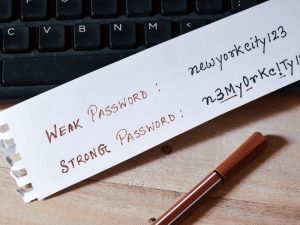
As Kansas ventures further into 2024, the cybersecurity landscape is evolving rapidly, presenting both challenges and opportunities for local businesses and residents. This blog post aims to provide a clear overview of the latest Kansas cybersecurity trends affecting our state, with practical advice on how to stay protected in an increasingly digital world.
Network Computer Solutions (NCS) has been a steadfast provider of IT services across the Midwest for over 25 years. Our deep understanding of the cybersecurity field makes us a reliable partner for businesses looking to navigate these changes.
Moving forward, we will delve into the specifics of cybersecurity risks, the financial implications of cyber threats, and the strategies that can help safeguard digital assets effectively. With NCS’s expertise, businesses can face the future with confidence, equipped with the knowledge to protect themselves against emerging cyber threats.
Overview:
Contrary to the common misconception that cybersecurity threats predominantly target major cities and large enterprises, small Kansas businesses are not exempt from digital dangers. This is best shown by Kansas ranking third for the highest malware spread, with a detection rate of 12.6% in SonicWall firewall sensors (SonicWall Cyberthreat 2023 Report). This statistic underscores the critical need for Kansas businesses to stay vigilant and informed about cyber threats as we journey through 2024.
Table of Contents
General Cybersecurity Risks and Trends

Cyber Threat Risks For Small Businesses
Cybersecurity is a concern most are aware of, yet the full scope of its potential impact remains underappreciated. Beyond the immediate threats to personal and company data, the financial implications can be staggering. Drawing on the Ponemon Institute’s 2019 Report, Global State of Cybersecurity in Small and Medium-Sized Businesses, the research highlights an increase in expenses related to cyberattacks, with companies spending an average of $1.2 million on the damage or theft of IT assets and infrastructure—up from $1.03 million in 2017. Additionally, 60% of small and medium-sized businesses that are hacked go out of business within six months (The Inc.). These statistics starkly illustrate the escalating economic burden of cybersecurity threats on businesses, underscoring the necessity for robust and proactive defense strategies.
General Cybersecurity Trends
Within cybersecurity, certain attack methods have emerged as particularly prevalent. Phishing and web-based attacks were the most common threat faced by small and medium-sized businesses with over 50% of businesses facing these threat (Ponemon Institute’s 2019). These methods will be discussed more later on, but in short, these cyber threats exploit human error and system vulnerabilities to gain unauthorized access to sensitive information.
One notable trend is the increasing difficulty in responding swiftly to cyberattacks. Only 26% of businesses reported an ability to reduce the time it takes to respond to such incidents (Ponemon Institute’s 2019). This statistic underscores a critical concern within the cybersecurity community: despite advancements in technology and strategy, a significant majority of organizations are finding it challenging to improve their response times.
The evolving digital workspace highlights a significant shift in cybersecurity vulnerabilities, particularly with mobile devices and laptops. Laptops as a vulnerable entry point to networks and enterprise systems has increased from 43% to 56% (Ponemon Institute’s 2019). Additionally, the reliance on mobile devices for accessing business-critical applications is growing, with an average of 48% of these applications now accessed via mobile devices, up from 45% in the previous year. These trends not only underscore the expanding attack surface but also indicate that nearly half of businesses believe these devices compromise their security posture, emphasizing the need for robust endpoint security strategies.
Kansas Cybersecurity Trends

Now focusing on Kansas, cybersecurity risks have distinctly impacted the state. In 2023, a total victim loss of $58,149,297 in Kansas alone, illustrating the significant financial toll of cybercrime (IC3 Internet Crime 2022 Report). Additionally, Kansas ranked third for the highest malware spread in 2023, with 12.6% of SonicWall firewall sensors detecting malware attempts(SonicWall Cyberthreat 2023 Report). This figure, while highlighting an ongoing risk, also shows a positive trend; the rate has been gradually decreasing from 26.7% in 2020 to 18.7% in 2022. Despite this improvement, the current rate emphasizes Kansas’s significant position in the national cybersecurity threat landscape, underscoring the necessity for continued and enhanced protective measures.
Kansas Cybersecurity Trends For 2024
Understanding Kansas Cybersecurity trends is having awareness of the predominant cyber threats. Here’s overview of the most common cyber threats facing businesses in 2024:
- Phishing: A deceptive technique aiming to steal sensitive data with 53% of businesses being affected by this threat(Ponemon Institute’s 2019).
- Web-based Attacks: These exploit website vulnerabilities to execute unauthorized actions, impacting 50% of businesses(Ponemon Institute’s 2019).
- Ransomware: Attacks have escalated, with a 68% increase in 2023(Malwarebytes Labs), representing a significant threat by encrypting victims’ data and demanding ransom for its release.
The trends and statistics outlined for Kansas illuminate the critical cybersecurity challenges facing the state. From substantial financial losses due to cybercrime to a notable rank in malware spread, these insights underscore the urgency for comprehensive cyber defense strategies. The prevalence of phishing, web-based attacks, and the significant rise in ransomware incidents highlight the evolving threat landscape. As Kansas navigates these cybersecurity trends, the emphasis on vigilance and adopting advanced protective measures in 2024 has never been more crucial to safeguard against these pervasive threats.
Staying Safe in 2024 – Best Practices

Strong and Unique Passwords
- Using complex, unique passwords for each account is critical. Changing passwords regularly can significantly reduce the risk of unauthorized access. Tools like Passportal offer a secure way to manage these passwords, making it easier for employees to maintain strong security practices.
Regular Software Updates
- Security vulnerabilities are often patched through software updates, making it essential to keep all systems up-to-date. By establishing policies that mandate regular updates and educating employees on their importance, businesses can enhance their defense against cyberattacks.
Beware of Common Cyber Threats
- Educating employees on how to recognize phishing emails, malicious links, and social engineering tactics is crucial. Regular training and updates on the latest cyber threats, combined with clear reporting mechanisms, can help build a proactive security culture.
Cybersecurity Training Programs
- Continuous learning through regular cybersecurity training sessions ensures that staff are aware of the latest threats and how to counteract them. Incorporating interactive modules and real-world scenarios can make these trainings more engaging and effective.
Multi-Factor Authentication (MFA)
- Adding an extra layer of security with MFA can significantly reduce the risk of unauthorized access. Ensuring that all employees are set up with MFA and understand its importance is key to strengthening an organization’s cybersecurity framework.
Role of IT in Kansas Cybersecurity
Managed Service Providers (MSPs) like NCS are integral to enhancing cybersecurity in Kansas businesses, especially given the state’s notable cyber threat challenges. MSPs provide comprehensive cybersecurity services tailored to address these prevalent threats. By managing firewalls, implementing effective encryption strategies, and conducting thorough security audits, MSPs ensure businesses are equipped to defend against the specific cyber threats that Kansas faces. Furthermore, their expertise in regulatory compliance helps safeguard sensitive data against breaches. Working with an MSP offers businesses a proactive approach to cybersecurity, aligning with Kansas’s unique digital landscape.
For businesses looking to enhance their cybersecurity posture, NCS offers comprehensive MSP services. With a focus on proactive protection and compliance, NCS tailors cybersecurity strategies to fit each business’s unique needs. Contact NCS for a consultation and explore how their MSP services can fortify your business’s cybersecurity defenses.
Conclusion
As we wrap up our discussion of Kansas’s cybersecurity landscape, it’s clear that the threats are evolving in 2024, but so are the strategies to combat them. From understanding the financial risks and prevalent cyber threats to adopting best practices and leveraging the expertise of MSPs like NCS, Kansas businesses are not alone in this fight. The collaboration between knowledgeable service providers and proactive businesses creates a formidable defense against cyber threats. NCS remains committed to safeguarding Kansas’s digital future, offering tailored solutions that address these challenges head-on. Together, we can navigate the complexities of cybersecurity, ensuring a safer, more secure online environment for all.



